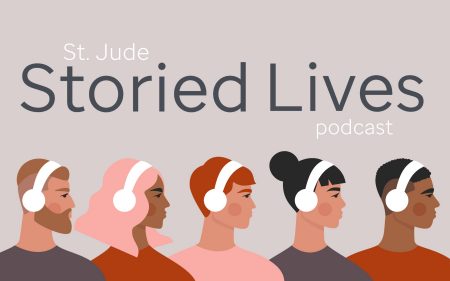
Patient No. 17
Danny Thomas said it would be worth building St. Jude if it saved just one child’s life. He might've been talking about a boy named Dwight Tosh.

January 17, 2019 • 8 min
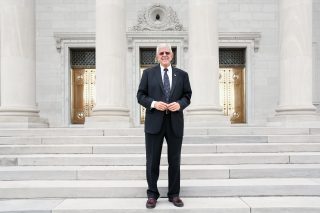
The boy was 13. He was country and talked with a drawl. He was tall for his age, and stout, and that was handy on the basketball court. Coach put him under the basket, so he could grab the rebounds, but he could handle the ball like a guard, too. And man, he loved to play.
“I was a really good ballplayer, not to brag on myself,” Dwight Tosh says, all these years later, remembering those days when the world was no bigger than a basketball, and every dream in reach. “Had it all going my way.”
This was in northeast Arkansas, 1962. A time of party lines, not cell phones. A time when a drive into Jonesboro, with a population of little more than 20,000 at the time, was like a trip to the big city; Memphis might as well have been the moon.
A simpler time, then — including for medical science, which was losing four in five children diagnosed with cancer.
So when the Tosh boy started to get sick — his skin breaking out, a fever — doctors in Jonesboro were puzzled. German measles? Scarlet fever? Then, as his condition only worsened, hospitalization — but for what, exactly?
“They could not get the fever down,” Tosh says. “I mean, we’re talking bumping 105, 106, even sometimes 107.
“Then a knot come up — a big ol’ knot,” he says, running a hand over his neck, feeling for the scar. “They did a biopsy of it, and when it came back, it was cancer.”
It was Hodgkin lymphoma, a cancer that starts in the lymph system, which is part of the immune system. The survival rate in children at the time was 50 percent — a coin flip. But Tosh’s case was so advanced that doctors called in family.
“Mom, I think she says, ‘Well, what are we looking at?’ ” Tosh says now. “She said the doctors told her, ‘Maybe two weeks.’ You just need to get ready, prepare for the worst, is what she said they told her.’ ”
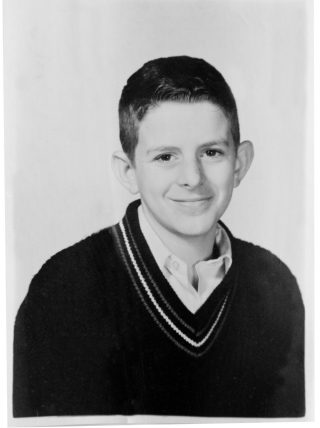
Dwight Tosh as a young boy.
The boy was 13, remember. He didn’t know cancer. He just wanted to be able to play basketball again — except he couldn’t stand on his own, much less walk. Had no appetite, for food or life. “Looked,” he says, “like my skin was just stretched over my bones.”
And then?
“I remember them telling me something about a hospital that opened,” Tosh says. “They said, ‘We’re going to take you over to Memphis.’ ”
A 70-mile ambulance ride, and he was carried on a stretcher through the doors of St. Jude Children’s Research Hospital.
It was April 22, 1962.
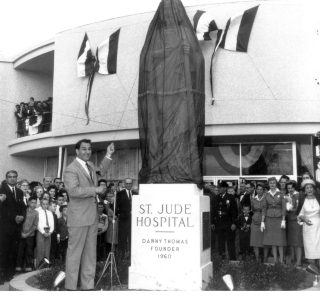
Danny Thomas prepares to unveil the statue of St. Jude Thaddeus at the opening of St. Jude Children's Research Hospital in 1962.
The hospital, named for the patron saint of hopeless causes and founded by entertainer Danny Thomas with the belief that “no child should die in the dawn of life,” had been open for all of 78 days.
Dwight Tosh was patient No. 17.
Hard times, and a sweetheart
It’s a bright, summer morning, 56 years and tens of thousands of patients later.
Tosh leaves his home outside Jonesboro for the two-hour drive to the state capitol in Little Rock. He’s a second-term state representative — District 52, mostly rural, like the man himself — with a couple of subcommittee meetings to attend.
He talks as he drives, past the town of Cash (Pop.: 342) and the Beebe water tower (“Home of the Badgers”), past John 3:16 Ministries and the Exit 48 Flea Market. He laughs a lot, tears up once, and mostly marvels at all that’s happened to him in a life nearly snuffed out before it really got going.

Dwight Tosh participates in a legislative meeting at the Arkansas State Capitol. He is a state representative for District 52.
He’s a husband of 48 years. A father of two and grandfather of four. A 37-year veteran of the Arkansas State Police, retiring as a captain. A third-term state representative. One of St. Jude’s longest-surviving patients and a supporter who has spoken about the hospital to groups across the country.
“You just think, if there’d been a delay of a few weeks opening those doors over there,” he says. “I didn’t have a few weeks.”
St. Jude in 1962 was a single building, and Tosh remembers going by tunnel to another hospital, St. Joseph, for radiation and chemotherapy treatment.
On a visit years later, with St. Joseph gone and St. Jude having grown into a sprawling, modern campus, Tosh found himself facing a hallway — the site, he was told, of the old tunnel.
“I’m going to tell you something,” he says, starting to tear up. “I stood there for a few minutes. I did. I looked down that hallway, and I visualized it. I could actually stand there and see that wheelchair, and that nurse, and see my mom, and us going down that tunnel. That was tough.”
There are happy memories, too. There was the day the Three Stooges came to visit the hospital. “Oh, that was pretty exciting,” he says. “They bounced around, you know, and we were all just laughing and they were cutting up.” Or the day a famous man he’d never heard of came by his room, sat on the side of the bed and said — one D.T. to another — “You know, you’re the reason I built this hospital.”
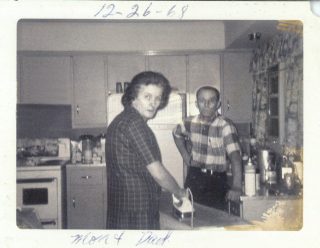
Dwight Tosh's parents, Opal and Jesse, in the kitchen in 1968, six years after Dwight was brought to St. Jude Children's Research Hospital for treatment of Hodgkin lymphoma.
Tosh’s mother was with him every moment at St. Jude. His father was mostly back home in Arkansas, working an extra shift at the shoe factory, because while St. Jude treatment has always been no-cost to families, there were bills from Tosh’s treatment in Jonesboro.
Hard times, then — and they didn’t end when Tosh returned home, successfully treated. Some parents balked at his return to school that fall, fearful their children would catch something from the sickly Tosh boy who’d been sent away to a new research hospital in Memphis.
“I couldn’t understand it at the time, but I understand it now,” Tosh says. “St. Jude had just come into existence. And it was called a research hospital. That scared people. They just didn’t know, didn’t understand.
“They were just being protective parents.”
But the superintendent said Tosh was welcome back, and the school board agreed. So began Tosh’s high school experience. And the best part of all that? His high school sweetheart, Joan.
“My wife, that’s a remarkable lady right there,” he says. It’s a recurring theme in Tosh’s conversations, all the way to the state capitol and back.
They’ve known each other nearly all their lives. They both lived in the country outside Jonesboro. Picked cotton together. Rode to church together.
“Ornery,” Joan says later in the day, when asked to describe young Dwight. “You know how boys are always playing tricks.”
They went to school together, too, and by Joan’s sophomore and Dwight’s junior year, they began to date — the most beautiful girl in school, he says, and “here I am, an ol’ sickly boy who’s still not fully recovered.”
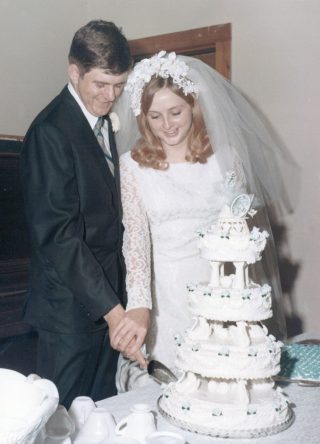
High school sweethearts, Dwight Tosh and his wife Joan have been married 48 years. Dwight refers to Joan as a "remarkable lady."
Then he turns serious and puts it another way: “You know, a lot of people were walking away from me. She walked straight towards me.”
Joan says her mother talked to her about it — about how Dwight might get sick again, might not be able to have children, and if he did, would they be healthy?
In the middle of everything
“I’m sure everybody thought that,” Joan says. “Nobody knew any different. I said, ‘Well, it doesn’t matter.’ When you love it doesn’t matter.”
Danny Thomas once said, “If we built this whole place and saved one child’s life, it would be worth it.”
He might have been talking about that other D.T. — Dwight Tosh, who became a state trooper despite doubts about his physical capabilities, despite questions about whether his cancer might return.
“Boy, I was determined, too,” he says. “I remember during recruit school — see, I had trouble walking. Even today, my arches in my feet are affected by it. I walk on my toes. I kind of have trouble running. I didn’t say anything. I was determined, whatever I had to do to compensate for it and overcome it. … And I made it.
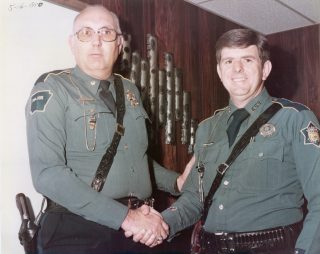
State Trooper Dwight Tosh receives a handshake from Major Buren Jackson upon Tosh's promotion to sergeant in 1980.
“I worked hard. I volunteered for stuff. I became a SWAT team leader. I became a hostage negotiator — I was trained by the FBI hostage negotiation team. … I mean, whatever it was, I wanted to be in the middle of it.”
Tosh says he was on a mission — to prove what’s possible for a cancer survivor, to show “you’re not just some poor, sickly child who’s lost the ability to do anything.”
He’s on a mission still. That’s how he describes his work as a legislator — a continuation, as he sees it, of his state police work: “I feel like I was put here to be a public servant.”
“He is passionate about everything that he decides to do,” says his daughter, Christy Tosh Crider, an attorney in Nashville. “He wants to experience it to the fullest, whether that’s being an incredible grandfather, whether that’s riding every ride when he took the kids to Silver Dollar City (theme park in Branson, Mo.).
“He’s never going to miss a ride. He’s never going to miss the fireworks show. He’s never going to miss an important event, because he favors all that, and he loves it.”
Tosh brags on his grandchildren — Christy’s two kids and her brother Brant’s two. He’s especially taken with their athletic exploits. You might say he’s living vicariously through them, because while Dwight wasn’t able to resume his basketball career after treatment, man, he still loves the game.
Brant, who lives in Jonesboro and followed his dad into the Arkansas State Police, tells a story.
“It was probably a month ago,” he says. “We’d been out to eat or somewhere, I can’t remember. It was late. My dad was telling my son about his form on free throws. It’s like 9:30 at night, and we’re all in the car talking. He’s like, ‘Son, we just need to go to the gym and work on it.’ Course, my son’s like, ‘Well, I’ll go right now.’
“You know, most folks my dad’s age, at 9:30 at night, the last thing they think about is loading the grandson up and taking him to a gym to work on free throws. I was worn out. So we got out and they left and went to a gym and shot basketball. I was asleep when he brought him home.”
Ah, basketball. It was Dwight Tosh’s first love — and, alas, a source of lasting regret.
“I never could go back to basketball,” he says. “I just couldn’t run. I wanted to, so bad. And I still think about it today. What if? You know. Just what if? Lot of coaches thought I had the potential. Then it was all boom — gone.”
He pauses, then says, “But if I’m never sick, who do I marry? My whole life might have changed. … I’d have never been a trooper. Me and my wife, we might never have had an interest in each another. Then the kids are not there.”
What if? — a cruel game, even when cancer isn’t involved. But it doesn’t take Tosh long to realize: Why play a game you’ve already won? Because he didn’t just survive, he’s thrived. He’s struck a blow for every kid who’s beaten cancer only to face the doubts some folks have about survivors. He’s lived a big and fulfilling life — family, career, second career, he’s had it all — and, at 70, he’s not done yet.
“I pinch myself,” he says now, laughing as he drives toward the state capitol, marveling at it all, at this life St. Jude made possible. “You’ve got to be kidding me.”



